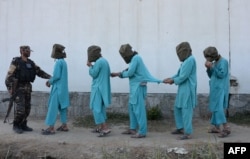In the remote eastern province of Nuristan, Afghan authorities are appealing to local elders for help in preventing militants loyal to the Islamic State (IS) from gaining new territory.
The move comes as fighters and their families seek new safe havens after recent U.S. and Afghan air strikes scattered the militants, aided by special forces ground operations.
Afghan authorities view Nuristan, a mountainous and forested province that borders Pakistan, as a potential new base for the self-proclaimed offshoot of IS. A series of high-profile attacks this year highlighted the insurgents’ desire to stoke sectarian tensions.
The prospect of an expanding IS has alarmed local officials as well as the U.S. military at a time when Afghan armed forces and their NATO allies are already struggling to handle a Taliban insurgency across much of the country.
Generally known by its Arabic name Daesh in Afghanistan, IS has so far largely been confined to the eastern province of Nangarhar, to Nuristan’s south. There it has clashed with other militants, including the Taliban, who have rejected it.
According to Afghan intelligence officials, an intense recent campaign of air strikes and raids by Afghan and U.S. special forces also pushed a lot of IS fighters out of Nangarhar and into neighboring Kunar Province.
Security officials reportedly gave weapons, ammunition, and other support to villages in Nuristan in a bid to foster defense against outsiders.
Hafez Abdul Qayum, the provincial governor, has held several meetings with local elders, who enjoy significant powers in a province where central government is weak.
"Whether it is the Taliban or Daesh, they are the most misguided people and the biggest destroyers of our religious values," Qayum, himself from Nuristan, told elders in Wama district. "Dear brothers, fighting against this menace is our biggest priority."
IS poses a fresh threat, according to Afghan security forces. By targeting the minority Shi’ite community, it risks making a dangerous insurgency led by the Taliban even harder to contain.
More than 30 people died in a suicide bombing claimed by IS at a Shi'ite mosque in Kabul.
The real power in Nuristan is widely considered to be the Qaomi Shura, or local elders' council. The province is seen as a natural buffer due to its singular culture, rugged mountain ranges, and lack of paved roads or electricity.
Security officials say they believe that if elders can be persuaded not to allow IS to settle, they will have a better chance of stopping its fighters from crossing from Pech Valley, where the Taliban and Al-Qaeda are also established.
IS fighters from different countries have found sanctuary in part of Kunar that includes an area known by U.S. troops as The Valley of Death, where they have lost dozens of soldiers.
The ongoing presence of Al-Qaeda was underlined in October, when a U.S. airstrike killed Farouq al-Qatari, the movement's top commander in the east.
So far, the IS presence is contained, as it seeks a foothold in an area hotly contested by other militant groups, and locals have been warned against giving help. But there is potential for its growth.
"They moved in with their families some months ago and only appear in mosques and do not roam around very often," said one official in Kunar, who spoke on condition of anonymity because he is not authorized to speak to the media. "They are trying to win local support and recruit young boys, the same method they used when they emerged in Nangarhar."
Regular drone strikes and special forces operations have hit IS hard this year in Afghanistan.
The United States refers to IS in Afghanistan as “operationally emergent,” which means capable of ordering deadly, high-profile attacks on civilian targets but posing a limited military threat.
General John Nicholson, the top U.S. commander in Afghanistan, has said IS suffered heavy casualties, with 12 top leaders killed and two dozen command and control facilities destroyed.
From nine districts, it now had sanctuary in only three.
However, Afghan officials fear that the IS offshoot, which they say includes extremists from Pakistan, could grow if fighters are pushed out of Iraq and Syria.
Officials worry that an unstable environment could allow militant groups to establish themselves in places where they would typically be shunned, and that religious affiliations could push some Nuristan residents to help IS fighters.
In Wama district, most residents are moderate Salafi followers, sharing an ideology similar to Wahhabism, the school of Sunni Islam from which Islamic State draws its religious ideology.
Taliban insurgents mainly follow the Hanafi school of Sunni Islam.
So far, locals have been quick to reassure visiting officials that such links will not influence them.
"Here, there is no place for Taliban or Daesh fighters. We don't want destruction and misery for our people," said Sheikh Gul Mohammad, an influential tribal figure.
Reporting by Hamid Shalizi for Reuters







